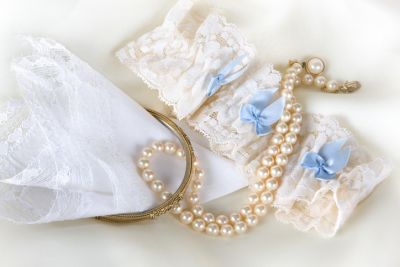 Planning your nuptials means giving careful thought to every detail involved. That includes typical wedding customs that might easily be taken for granted. Whether you’re a traditional type at heart or you want to take your celebration off the beaten path, you can better craft your ceremony and reception in a unique way once you understand the origins of many common matrimonial practices.
Planning your nuptials means giving careful thought to every detail involved. That includes typical wedding customs that might easily be taken for granted. Whether you’re a traditional type at heart or you want to take your celebration off the beaten path, you can better craft your ceremony and reception in a unique way once you understand the origins of many common matrimonial practices.
“You Can’t See the Bride Before the Wedding!”
One ubiquitous superstition that remains with us is the idea that the bride and groom should never lay eyes on each other right before the wedding. Some variations of the belief go as far as to assert that a groom shouldn’t see his bride’s dress at all, no matter how far in advance it is before the big day. While sources disagree on exactly why this custom was adopted, Bridal Guide contributor Kelsie Allen revealed that its origins may lie with arranged marriages. To guarantee a successful union and avert a last-minute cancellation, neither the bride nor the groom were permitted to see each other before the ceremony. Moreover, Allen suggests a surreptitious motive for the bridal veil: to prevent the groom from seeing his intended until right at the altar, where he likely would not back out.
Wedding Veils and Evil Spirits
Speaking of veils, they also have their own roots in superstitious beliefs surrounding weddings. Ancient cultures viewed marriage (and the children resulting from them) as a necessary cornerstone for a society’s survival. A 2013 CNN article disclosed that wedding veils date back to pre-Christian Rome, when evil spirits were considered a real threat that could disrupt a couple’s nuptials. To confuse such malevolent eidolons and prevent them from recognizing the bride, she was draped in a veil.
Bridesmaids: Another “Spirited” Custom?
Depending on who you ask, the inclusion of bridesmaids in one’s wedding may be for practical or spiritual reasons. In a July 2016 Bustle piece, contributor Marissa Higgins mentioned that ancient Roman weddings required 10 witnesses to be legally binding. Furthermore, bridal attendants dressed in identical attire to fool any malicious spirits who wished harm on the couple. In other areas of the world, bridesmaids served a more unusual purpose: to deceive any would-be rival suitors who wanted to kidnap the bride! It wasn’t until Victorian-era England that the role of a wedding attendant transmuted into its more recognizable modern version, according to Higgins. At that time, bridesmaids began to help their marrying friends with small tasks such as making wedding favors and arranging flowers for the ceremony.
“Borrowed and Blue” Good Luck Charms
Ever hear the phrase “something old, something new, something borrowed, something blue”? These lines are part of an old English nursery rhyme that describes a set of good luck tokens to be carried by the bride. A brief explanation from The Knot details some of the symbolism behind these charms: continuity, optimism, happiness and fidelity. In older times, they were also considered to be protective charms for the marriage, and any children born of it, and some versions add “a sixpence in the shoe” to ward off evil intentions from rejected suitors.
What’s Luck Got to Do With It?
Before modern times, humans invested a lot of belief in superstition and unseen spiritual forces. Following certain wedding customs was seen as important steps to ensure good fortune and avoid angering any relevant deities. Although many of us aren’t necessarily beholden to a fear of bad luck, the backstories behind customary wedding traditions can prove to be fascinating. Having this knowledge can also be useful, as understanding the meanings of these practices can help you create your wedding day to be a unique reflection of your beliefs, values and aesthetics.
Add Your Comment